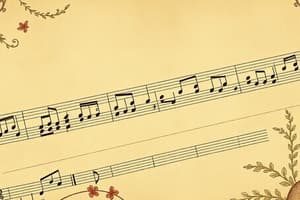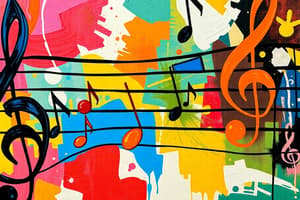Podcast
Questions and Answers
What is indicated by the top number in a time signature?
What is indicated by the top number in a time signature?
- The type of note that receives one beat.
- The number of beats in each measure. (correct)
- The length of the notes in a measure.
- The overall tempo of the music.
What defines a rhythmic pattern in music?
What defines a rhythmic pattern in music?
- A combination of melody and harmony.
- A single note played multiple times.
- A series of varied pitches.
- A repeated sequence of notes and/or rests. (correct)
Which time signature is commonly known as 'common time'?
Which time signature is commonly known as 'common time'?
- 3/4
- 2/4
- 4/4 (correct)
- 6/8
Which of the following options describes complex rhythmic patterns?
Which of the following options describes complex rhythmic patterns?
What does the bottom number of a time signature represent?
What does the bottom number of a time signature represent?
Why is understanding rhythmic patterns important in music?
Why is understanding rhythmic patterns important in music?
Flashcards
Musical Meter
Musical Meter
The organized arrangement of beats in music.
Note Value
Note Value
The length of time a note lasts in a musical piece.
Time Signature
Time Signature
Indicates the rhythm pattern (beats per measure) and which note equals one beat.
Whole Note
Whole Note
Signup and view all the flashcards
Quarter Note
Quarter Note
Signup and view all the flashcards
Time Signature 4/4
Time Signature 4/4
Signup and view all the flashcards
Study Notes
Notes and Rest Meter
1. Definition
- Meter: The rhythmic structure of music, determined by the grouping of beats.
- Notes and Rests: Symbols representing sound (notes) and silence (rests) in music.
2. Notes
- Whole Note: 4 beats; represented by an open note head with no stem.
- Half Note: 2 beats; open note head with a stem.
- Quarter Note: 1 beat; filled note head with a stem.
- Eighth Note: 1/2 beat; filled note head with a stem and a flag.
- Sixteenth Note: 1/4 beat; filled note head with a stem and two flags.
3. Rests
- Whole Rest: 4 beats of silence; represented by a rectangular shape hanging from the second line.
- Half Rest: 2 beats of silence; a rectangular shape sitting on the third line.
- Quarter Rest: 1 beat of silence; a squiggly symbol.
- Eighth Rest: 1/2 beat of silence; similar to an eighth note but without a note head and with a single flag.
- Sixteenth Rest: 1/4 beat of silence; similar to an eighth rest but with two flags.
4. Time Signatures
- Indicate how many beats are in each measure and what note value is equivalent to one beat.
- Common time signatures:
- 4/4: Four beats per measure; quarter note gets one beat.
- 3/4: Three beats per measure; quarter note gets one beat.
- 2/4: Two beats per measure; quarter note gets one beat.
- 6/8: Six beats per measure; eighth note gets one beat.
5. Importance of Meter
- Establishes the tempo and feel of the music.
- Guides the performer in rhythm and phrasing.
- Influences the overall structure and flow of a piece.
6. Practice Techniques
- Clapping: Practice clapping rhythms to internalize meter.
- Counting Aloud: Count beats while playing or singing to reinforce understanding of meter.
- Subdividing: Break down complex rhythms into smaller, manageable parts (e.g., counting in eighths or sixteenths).
7. Application
- Understanding notes and rests in meter helps in reading, performing, and composing music.
- Essential for musicians across all genres for maintaining rhythmic accuracy.
Definition
- Meter is the rhythmic structure of music, created by grouping beats.
- Notes represent sound, while rests symbolize silence in musical compositions.
Notes
- Whole Note: Lasts for 4 beats, depicted by an open note head without a stem.
- Half Note: Holds 2 beats, shown as an open note head with a stem.
- Quarter Note: Consists of 1 beat, illustrated by a filled note head with a stem.
- Eighth Note: Contains 1/2 beat, characterized by a filled note head, stem, and a flag.
- Sixteenth Note: Equal to 1/4 beat, marked by a filled note head, stem, and two flags.
Rests
- Whole Rest: Represents 4 beats of silence, visually a rectangle hanging from the second line.
- Half Rest: Indicates 2 beats of silence, shaped like a rectangle resting on the third line.
- Quarter Rest: Signifies 1 beat of silence, depicted as a squiggly symbol.
- Eighth Rest: Represents 1/2 beat of silence, similar to an eighth note but without a note head and possessing a single flag.
- Sixteenth Rest: Conveys 1/4 beat of silence, akin to an eighth rest but with two flags.
Time Signatures
- Time signatures show the number of beats per measure and what note value counts as one beat.
- 4/4: Four beats per measure; quarter note equals one beat.
- 3/4: Three beats per measure; quarter note equals one beat.
- 2/4: Two beats per measure; quarter note equals one beat.
- 6/8: Six beats per measure; eighth note equals one beat.
Importance of Meter
- Establishes the tempo and overall feel of a musical piece.
- Provides guidance for performers in rhythm and phrasing.
- Affects the structure and flow of the composition.
Practice Techniques
- Clapping: Reinforces meter by clapping out rhythms.
- Counting Aloud: Aids in grasping meter by counting beats during performance.
- Subdividing: Simplifies complex rhythms into smaller segments, like counting eighths or sixteenths.
Application
- Proficient understanding of notes and rests in meter is crucial for reading, playing, and composing music.
- Essential for musicians across various genres to maintain rhythmic precision.
Rhythmic Pattern
- A rhythmic pattern is a sequence of notes and rests that determines the tempo and mood of music.
- Beats serve as the fundamental unit of time in musical compositions.
- Rests indicate moments of silence that contribute to the overall rhythm.
- Simple patterns feature regular rhythms like quarter notes, which are easily identifiable.
- Complex patterns incorporate syncopation or irregular rhythms, adding depth and intricacy.
- Rhythmic patterns are vital in establishing the groove and feel, guiding both performers and listeners.
Time Signature
- A time signature shows the number of beats per measure and identifies which note value equals one beat.
- The time signature is expressed as two numbers (e.g., 4/4):
- The top number signifies the count of beats in each measure.
- The bottom number denotes the note value that gets one beat (e.g., 4 for quarter notes).
- Common time signatures include:
- 4/4, recognized as "common time," is widely used across genres.
- 3/4 characterized as waltz time, consists of three beats per measure.
- 2/4, often utilized in marches, contains two beats per measure.
- 6/8 represents compound time with six beats per measure, conveying a compound feel.
- Certain musical pieces may shift between time signatures, creating varying rhythmic dynamics.
- Time signatures provide structure and a rhythmic framework, which significantly affects the music's feel and style.
Studying That Suits You
Use AI to generate personalized quizzes and flashcards to suit your learning preferences.




